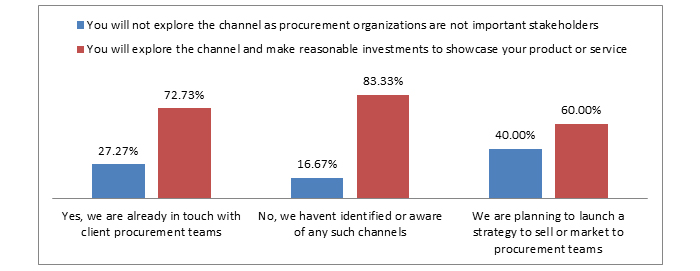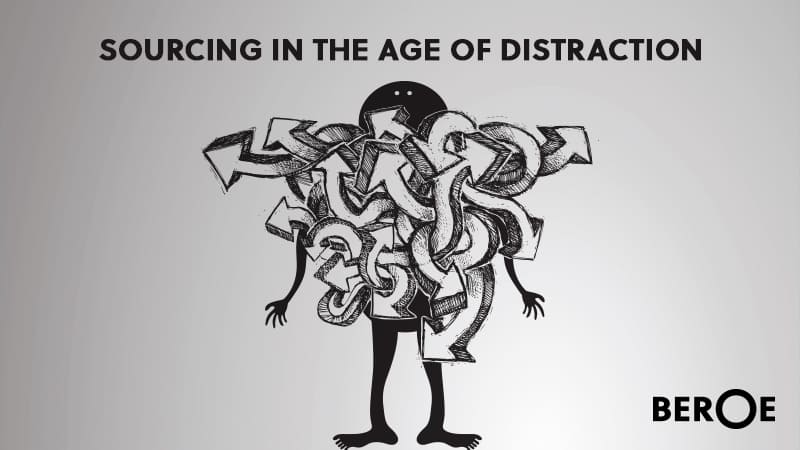
Sourcing in the Age of Distraction

Data Collection and Compilation by Navami Reghunath
Information Overload
The digital age has ushered in multitudes of information channels. Procurement managers have to sift through large amounts data and information in order to make the best sourcing decisions. This often leads to ‘information overload’, a phrase that was popularized by Alvin Toffler in his book ‘Future Shock’, published in the 1970s.
The digital age has also ushered in a plethora of Internet-enabled devices, resulting in what is known as the ‘Age of Distraction’. For instance, a survey of British workers has revealed that employees spend less than 40 percent of the day actually doing their primary duties due to a culture of excessive meetings and emails. (https://www.weforum.org/agenda/2016/10/our-workplaces-are-full-of-distractions-these-are-some-of-the-worst)
Procurement Organizations are not immune to such ‘siren calls’ of distraction. The new challenge facing Procurement Organizations is to select the right supplier, execute the right contract, pay the right price and optimally manage the cost base, while simultaneously and effectively managing noise and distraction.
Increasing Spend under Management
Managing distraction and noise is important because, as per a survey by Capgemini Consulting, spend under the management of procurement has significantly increased in 2015–2016. For direct categories, nearly 70 percent of respondents reported that 60 percent or more of total spend is managed by procurement, with half reporting that over 80 percent of spend is managed.
For indirect categories, the figures were lower on average, but still significantly higher than the findings in 2013. Just over 45 percent of respondents indicated that 60 percent or more of total indirect spend falls under the purview of procurement, with 28 percent reporting that over 80 percent is managed.
As per the survey report, the positive trend in increased spend under management reinforces the notion that companies are increasingly recognizing the value that procurement can provide to their internal business partners.
This trend has not gone unnoticed in the sales and marketing circles across the globe. Selling to procurement is slowly gaining prominence. For certain offerings—such as e-procurement, spend analytics, etc.—Procurement Organizations are the direct customer. However, for a large number of categories, sourcing teams are emerging as an important internal influencer. In fact, a survey by Beroe has shown that sales and marketing teams of supplier organizations are planning to capitalize on this front.
Does Procurement’s Opinion Matter?
The mood in the sales and marketing circles can be summarized as follows.
Procurement professionals often do not express an inclination to be inundated with sales calls. However, when sales teams have been specifically requested to contact procurement, but the latter do not engage—by phone or email—companies are considered to not necessarily receive the best value.
In order to better understand if Procurement Organizations matter as a target audience for sales and marketing professionals, Beroe conducted a survey on the importance of selling to Procurement Organizations.
The Survey
Sixty percent of sales and marketing professionals said that they deal with the procurement teams of client organizations, and nearly 70 percent of them opined that client Procurement Organizations are either internal influencers or important stakeholders.
1. Do you deal with procurement teams of client organizations when you sell or market your company’s product/ service?

If yes, how often have you experienced procurement teams of your client organizations involved in the buying processes?

Interestingly, more than 90 percent of respondents said they either had a prior plan to sell to procurement or it was business as usual to be dealing with client sourcing teams. This underpins the growing importance of Procurement Organizations.
3. When your client’s procurement team involved itself in business discussions, were you?

When asked whether it is important to have a marketing and sales plan for gaining trust among procurement teams, a whopping 80 percent have said it is more important to have a plan to sell to procurement.
4. Do you think going forward it is important to have a marketing and sales plan for gaining trust among procurement teams?

If you are provided a channel to market or sell exclusively to procurement

The graph below combines the responses to question numbers 4 and 5. Among those who feel it is important to have a marketing and sales plan for gaining trust among procurement teams, nearly 77 percent said they are willing to explore if they are provided a channel to market or sell exclusively to procurement. In a way, this finding shows that no such exclusive channel exist as yet.

Cold Calls and Emails - Frustration
Owing to the lack of exclusive channel to sell or market to Procurement Organizations, sales organizations usually bombard procurement managers with cold emails and phone calls that, at times, lead to unsavory situations. The inability to effectively reach out to Procurement Organizations often leads to frustration among sales and marketing teams.

The frustration is all the more amplified simply because sales and marketing professionals are becoming aware of the growing influence of procurement in an organization’s buying decisions.
Are you aware that Procurement Organizations around the world are gaining more clout in a company’s purchase decisions?

Impossibility of Covering the Entire Waterfront
With their growing importance in an organization’s buying decisions, it is natural for procurement managers to experience increasing attention from the sales and marketing teams in the days to come.
Amidst the surge of attention that they will receive, it is impossible for them to cover the entire waterfront of gathering necessary data and information in order to make the right ‘Buy or No Buy’ decisions.
Danger of Getting Caught in an Information Whirlpool
Today, data is not only collected and analyzed at rapid frequency, but also constantly referenced for predictive analysis. While it is essential for procurement teams to use real-time flow of insights to shape and inform the entire decision-making process, they may often encounter multiple challenges, including:
Identifying how, where and when to source high-quality data.
Using available data to predict and understand the effects of global trends and political turmoil. For example, the speed at which the BREXIT vote took place caught the entire business community by surprise. This type of situation could have been avoided by preparing a reliable scenario analysis.
Developing in-house procurement knowledge. This often involves reading through large volumes of expensive industry journals and relevant online information. As such, it is difficult to build a full-fledged in-house market intelligence team from scratch.
Buyer Meets Seller—Choosing the Right Online Ecosystem
While generic intelligence is widely available on the Internet, it is not always easy to locate relevant, reliable and specific intelligence that would fit the buyer’s sourcing context. From a seller’s point of view, generating qualified leads is not possible without a dedicated marketing plan aimed at the procurement audience—cold calls and emails can only take one so far.
Hence, it is imperative for both procurement teams and suppliers to interact—directly or indirectly—with each other within a unified ecosystem that would help them to stay focused. Ideally, the ecosystem should be non-intrusive, as well as non-invasive, for both buyers and sellers.
As their profile rises, procurement managers will find it difficult to manage the surge of incoming marketing and sales reach-outs through plethora of channels. On the other hand, for sellers, it would be ideal if they are allowed to channelize their marketing efforts without resorting to cold calls or emails.
It is important to remember the perils of succumbing to the ‘siren calls’ of distraction.
While choosing to participate in an online ecosystem, buyers and sellers should consider the following capabilities:
Depth of Expertise: Does the ecosystem have a peer network of sourcing managers, category heads, suppliers, industry experts and other relevant professionals? Furthermore, consider the range of industries and verticals covered.
Access to Intelligence: The ecosystem should offer real-time, on-demand access to reports and category data through a self-service platform, allowing buyers to easily engage with the services over the cloud. This type of effort can cut down turnaround time by almost 80 percent.
A Library of Thought Leadership: Does the intelligence provider have a library of informative thought leadership, such as whitepapers, articles, blogs, etc., written by independent experts?
Peer Network: Identify if there are opportunities for you as a buyer to contribute to the peer network. As a buyer, will you get access to polls, supplier ratings and peer group discussions that are good indicators of market benchmarks?
Supplier Showcase: It is essential for a two-way flow of information to exist between the supplier and the buyer. Can the ecosystem double up as an effective channel for suppliers to promote their thought leadership material aimed at their target audience, that is, procurement?
Conclusion
An online ecosystem, which has all of the above characteristics, will be beneficial for both procurement managers and business development teams of supplier organizations. It would help them stay focused in this age of distractions.
Related Insights:
View All
Get more stories like this
Subscirbe for more news,updates and insights from Beroe







